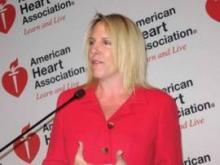LOS ANGELES – If you look old for your chronologic age, chances are your coronary arteries are undergoing accelerated biologic aging, too, judging from findings in a new report from the landmark Copenhagen City Heart Study.
Several specific skin signs of aging serve as significant predictors of increased risk for ischemic heart disease independent of chronologic age and the standard cardiovascular risk factors, Dr. Anne Tybaerg-Hansen reported at the annual scientific sessions of the American Heart Association.
"I think this is pretty useful information clinically. If you look at your patients right, it’ll give you an idea of their cardiovascular health independent of their chronologic age. And when you see these traits that are not dependent on the well-known cardiovascular risk factors, then you should perhaps treat them more diligently, because their 10-year risk is higher than in individuals in the same age groups who do not have these aging signs," explained Dr. Tybaerg-Hansen, professor of clinical biochemistry at the University of Copenhagen.
When nearly 11,000 participants in the prospective Copenhagen City Heart Study had their first physical examination back in 1976-1978, investigators blinded as to subjects’ health status systematically recorded visible signs of aging using prespecified criteria. Since then, during a mean follow-up of 35 years, there have been 3,401 ischemic heart disease events, including 1,708 acute MIs, in these subjects.
In a multivariate analysis extensively adjusted for potential confounders, several classic signs of aging proved unrelated to the risk of future ischemic heart disease. Neither wrinkles, grey hair, nor arcus corneae – that is, cholesterol deposits in the eye – were independently related to risk. That implies these features are fully accounted for by chronologic age and conventional cardiovascular risk factors.
However, four aging signs remained independent predictors of increased risk after controlling for age, gender, all the standard cardiovascular risk factors, socioeconomic status, body mass index, and physical activity. Xanthelasma – yellowish deposits of cholesterol around the eyelids – was associated with a 35% increased risk of MI during follow-up. An earlobe crease was associated with a significant 11% increased risk. Crown top baldness carried a 40% increase in relative risk, while frontoparietal baldness was associated with a 14% greater risk.
These two forms of baldness were significant predictors in men only. Crown top and frontoparietal baldness also were linked to increased MI risk in women, but this association didn’t achieve statistical significance because so few women experience these aging signs.
The more of the four aging signs present at baseline, the greater the risk of subsequent acute MI. Nine percent of subjects had three or all four aging signs; their risk of acute MI was 60% greater than in individuals with none of the aging signs in the adjusted analysis. Those with one or two aging signs had increased risks of roughly 20% and 35%, respectively.
This stepwise increase in risk held true across all 10-year age groups. Among 70- to 79-year-old men, for example, those with three or four of the aging signs had a 44% absolute 10-year risk of ischemic heart disease, while those with none of the signs had a 32% risk.
Asked to speculate about the mechanisms underlying the association between the aging signs and ischemic heart disease, Dr. Tybaerg-Hansen was quick to note that "there are no scientific data at all" for guidance. That being said, high free-testosterone levels are associated with male-pattern baldness, and some studies have reported a link between free testosterone and ischemic heart disease. Also, Dr. Tybaerg-Hansen and her coworkers recently demonstrated that the increased risk of ischemic heart disease associated with xanthelasma cannot be explained by serum cholesterol or triglyceride levels (BMJ 2011;343:d5497).
"So there must be something else, probably something in the connective tissue, which makes some people more prone to accumulate cholesterol. Connective tissue could also be involved in the earlobe crease. But there is as yet no hard evidence for this," she said.
Session chair Dr. Kathy Magliato, a cardiothoracic surgeon and director of women’s cardiac services at St. John’s Health Center in Los Angeles, said that the new Copenhagen City Heart Study findings confirm her own anecdotal experience.
"The majority of people who come to me because they’ve missed out on the benefits of prevention and now need heart surgery look old for their age. It’s reassuring to know now that I’m not just imagining that. The older they look, the worse their heart disease," she said.
"This study reinforces the fact that we have to look at our patients," Dr. Magliato continued. "I think doctors are sometimes so rushed to put on a blood pressure cuff and get a stethoscope on the chest that we forget to just step back and look at these visible signs of aging."



